Groundwater Chemical Trends Analyses in the Piedmont Po Plain (NW Italy): Comparison with Groundwater Level Variations (2000–2020)
Abstract
:1. Introduction
2. Materials and Methods
2.1. Study Area
2.1.1. Geological and Hydrogeological Setting
- Recent fluvial deposits (FS1) (Upper Pleistocene–Holocene): fluvial (Holocene) and fluvioglacial (Upper Pleistocene) deposits, mainly gravelly sandy but also silty-clayey. These deposits are located in the bottom of the valleys and in the plain with a prevalent permeability for porosity ranging from high to medium.
- Medium and ancient fluvial deposits (FS2) (Middle–Lower Pleistocene): mainly composed of gravelly sandy and silty-clay deposits. These deposits border the Apennine–Alps chains and are in contact with morainic glacial deposits. A prevalent permeability of medium grade linked to porosity appears, with a lower degree of permeability occurring mainly in the oldest and altered terms. A shallow unconfined aquifer, locally confined, is present in continuity with the aquifer hosted in the FS1 complex.
2.1.2. Hydrochemical and Land-Use Setting
2.2. Materials and Methods
3. Results
4. Discussion
5. Conclusions
Supplementary Materials
Author Contributions
Funding
Data Availability Statement
Conflicts of Interest
References
- Lapworth, D.J.; Lopez, B.; Laabs, V.; Kozel, R.; Wolter, R.; Ward, R.; Amelin, E.V.; Besien, T.; Claessens, J.; Delloye, F.; et al. Devoloping a groundwater watch list for substances of emerging concern: A European perspective. Environ. Res. Lett. 2019, 14, 035004. [Google Scholar] [CrossRef]
- Dao, P.U.; Heuzard, A.G.; Le, T.X.H.; Zhao, J.; Yin, R.; Shang, C.; Fan, C. The impacts of climate change on groundwater quality: A review. Sci. Total Environ. 2024, 912, 16924. [Google Scholar] [CrossRef] [PubMed]
- Earman, S.; Dettinger, M. Potential impacts of climate change on groundwater resources—A global review. J. Water Clim. Chang. 2011, 2, 213–229. [Google Scholar] [CrossRef]
- Vespasiano, G.; Muto, F.; Apollaro, C. Geochemical, Geological and Groundwater Quality Characterization of a Complex Geological Framework: The Case Study of the Coreca Area (Calabria, South Italy). Geosciences 2021, 11, 121. [Google Scholar] [CrossRef]
- Grant, F.F.; Szponar, N.; Edwards, B.A. Groundwater Microbiology; The Groundwater Project: Guelph, ON, Canada, 2021. [Google Scholar]
- Howard, K. Urban Groundwater; The Groundwater Project: Guelph, ON, Canada, 2023. [Google Scholar] [CrossRef]
- Pascoli-Campbell, M.; Reager, J.T.; Hrishikesh, A.C.; Rodell, M. Retracted article: A 10 per cent increase in global land evapotranspiration from 2003 to 2019. Nature 2021, 593, 543–547. [Google Scholar] [CrossRef] [PubMed]
- Stigter, T.Y.; Miller, J.; Chen, J.; Re, V. Groundwater and climate change: Threats and opportunities. Hydrogeol. J. 2023, 31, 7–10. [Google Scholar] [CrossRef]
- Riedel, T.; Weber, T.K.D. Review: The influence of global change on Europe’s water cycle and groundwater recharge. Hydrogeol. J. 2020, 28, 1939–1959. [Google Scholar] [CrossRef]
- Cross, K.; Latorre, C. Which water for which use? Exploring water quality instruments in the context of a changing climate. Aquat. Procedia 2015, 5, 104–110. [Google Scholar] [CrossRef]
- Dragoni, W.; Sukhija, B.S. Climate change and groundwater: A short review. Geolog. Soc. Lond. 2008, 288, 1–12. [Google Scholar] [CrossRef]
- Swain, S.; Taloor, A.K.; Dhal, L.; Sahoo, S.; Al-Ansari, N. Impact of climate change on groundwater hydrology: A comprehensive review and current status of the Indian hydrogeology. Appl. Water Sci. 2022, 12, 120. [Google Scholar] [CrossRef]
- Jutglar, K.; Hellwig, J.; Stoelzle, M.; Lange, J. Post-drought increase in regional-scale groundwater nitrate in southwest Germany. Hydrol. Process. 2021, 35, e14307. [Google Scholar] [CrossRef]
- Saavedra, F.; Musolff, A.; von Freyberg, J.; Merz, R.; Knoller, K.; Muller, C.; Brunner, M.; Tarasova, L. Winter post-droughts amplify extreme nitrate concentrations in German rivers. Environ. Res. Lett. 2024, 19, 024007. [Google Scholar] [CrossRef]
- Van Vliet, M.T.H.; Zwolsman, J.J.G. Impact of summer droughts in the water quality of the Meuse river. J. Hydrol. 2008, 353, 1–17. [Google Scholar] [CrossRef]
- Santacruz-De Leòn, G.; Moran-Ramìrez, J.; Ramos-Leal, J.A. Impact of drought and groundwater quality on agriculture in a semi-arid zone of Mexico. Agriculture 2022, 12, 1379. [Google Scholar] [CrossRef]
- Egidio, E.; Mancini, S.; De Luca, D.A.; Lasagna, M. The impact of climate change on groundwater temperature of the Piedmont Po Plain (NW Italy). Water 2022, 14, 2797. [Google Scholar] [CrossRef]
- Lasagna, M.; Egidio, E.; De Luca, D.A. Groundwater temperature stripes: A simple method to communicate groundwater temperature variation due to climate change. Water 2024, 16, 717. [Google Scholar] [CrossRef]
- Keil, D.; Niklaus, P.A.; von Riedmatten, L.R.; Boeddinghaus, R.S.; Dormann, C.F.; Scherer-Lorenzen, M.; Kandeler, E.; Marhan, S. Effects of warming and drought on potential N2O emissions and denitrifying bacteria abundance in grasslands with different land-use. Microb. Ecol. 2015, 91, fiv066. [Google Scholar] [CrossRef] [PubMed]
- United Nations. The United Nations World Water Development Report 2022: Groundwater: Making the Invisible Visible; Unesco: Paris, France, 2022. [Google Scholar]
- Rotiroti, M.; Bonomi, T.; Sacchi, E.; McArthur, J.; Stefania, G.A.; Zanotti, C.; Taviani, S.; Patelli, M.; Nava, V.; Soler, V.; et al. The effects of irrigation on groundwater quality and quantity in a human-modified hydro-system: The Oglio River basin, Po Plain, northern Italy. Sci. Total Environ. 2019, 672, 342–356. [Google Scholar] [CrossRef] [PubMed]
- Bouwer, H. Effect of irrigated agriculture on groundwater. J. Irrig. Drain. Eng. 1987, 113, 4–15. [Google Scholar] [CrossRef]
- Chen, S.; Wu, W.; Hu, K.; Li, W. The effects of land use change and irrigation water resource on nitrate contamination in shallow groundwater at county scale. Ecol. Complex. 2010, 7, 131–138. [Google Scholar] [CrossRef]
- Rattan, R.K.; Datta, S.P.; Chhonkar, P.K.; Suribabu, K.; Singh, A.K. Long-termimpact of irrigation with sewage effluents on heavy metal content in soils, crops and groundwater—A case study. Agric. Ecosyst. Environ. 2005, 109, 310–322. [Google Scholar] [CrossRef]
- Yesilnacar, M.I.; Gulluoglu, M.S. Hydrochemical characteristics and the effects of irrigation on groundwater quality in Harran plain. GAP Project, Turkey. Environ. Geol. 2008, 54, 183–196. [Google Scholar] [CrossRef]
- Rotiroti, M.; Sacchi, E.; Caschetto, M.; Zanotti, C.; Fumagalli, L.; Biasibetti, M.; Bonomi, T.; Leoni, B. Groundwater and surface water nitrate pollution in an intensively irrigated system: Sources, dynamics and adaptation to climate change. J. Hydrol. 2023, 623, 129868. [Google Scholar] [CrossRef]
- McQuiggan, R.; Scott Andres, A.; Roros, A.; Sturchio, N.C. Stormwater drives seasonal geochemical processes beneath an infiltration basin. J. Environ. Qual. 2022, 51, 1198–1210. [Google Scholar] [CrossRef] [PubMed]
- Perera, N.; Gharabaghi, B.; Howard, K. Groundwater chloride response in the Highland Creek watershed due to road salt application: A re-assessment after 20 years. J. Hydrol. 2013, 479, 159–168. [Google Scholar] [CrossRef]
- Francani, V. Alcuni aspetti idrochimici delle zone di scambio fra acque superficiali e sotterranee. Acque Sotter.-Ital. J. Groundw. 2013, 2, 51–52. [Google Scholar] [CrossRef]
- Nathan, R.; Evans, R. Groundwater and surface water connectivity. In Water Resources Planning and Management; Cambridge University Press: Cambridge, UK, 2011; pp. 46–67. [Google Scholar] [CrossRef]
- Uhl, A.; Hahn, H.J.; Jager, A.; Luftensteiner, T.; Siemensmeyer, T.; Doll, P.; Noack, M.; Schwenk, K.; Berkhoff, S.; Weiler, M.; et al. Making waves: Pulling the plug—Climate change effects will turn gaining into losing streams with detrimental effects on groundwater quality. Water Res. 2022, 220, 118649. [Google Scholar] [CrossRef]
- Colmenero-Chacòn, C.P.; Morales-deAvila, H.; Gutièrrez, M.; Esteller-Alberich, M.V.; Alarcòn-Herrera, M.T. Enrichment and temporal trends of groundwater salinity in Central Mexico. Hydrology 2023, 10, 194. [Google Scholar] [CrossRef]
- Morales-deAvila, H.; Gutierrez, M.; Colmenero-Chacòn, C.P.; Junez-Ferreira, H.E.; Esteller-Alberich, M.V. Upward trends and lithological and climatic controls of groundwater arsenic, fluoride and nitrate in Central Mexico. Minerals 2023, 13, 1145. [Google Scholar] [CrossRef]
- Barbieri, M.; Barberio, M.D.; Banzato, F.; Billi, A.; Boschetti, T.; Franchini, S.; Gori, F.; Petitta, M. Climate change and its effect on groundwater quality. Environ. Geochem. Health 2023, 45, 1133–1144. [Google Scholar] [CrossRef]
- Charlier, J.B.; Tourenne, D.; Hévin, G.; Desprats, J.F. NUTRI-Karst-Réponses des Agro-Hydro-Systèmes du Massif du Jura Face au Changement Climatique et Aux Activités Anthropiques. Rapport final de la Tache 1V1. BRGM/RP-72229-FR. 2022. 238p. Available online: http://ficheinfoterre.brgm.fr/document/RP-72229-FR (accessed on 14 March 2024).
- Li, C.; Zhang, X.; Gao, X.; Li, C.; Jiang, C.; Liu, W.; Lin, G.; Zhang, X.; Fang, J.; Ma, L.; et al. Spatial and Temporal Evolution of Groundwater Chemistry of Baotu Karst Water System at Northern China. Minerals 2022, 12, 348. [Google Scholar] [CrossRef]
- Urresti-Estala, B.; Gavilàn, P.J.; Pérez, I.V.; Carrasco Cantos, F. Assessment of hydrochemical trends in the highly anthropised Guadalhorce River basin (southern Spain) in terms of compliance with the European groundwater directive for 2015. Environ. Sci. Pollut. Res. 2016, 23, 15990–16005. [Google Scholar] [CrossRef] [PubMed]
- Stuart, M.E.; Chilton, P.J.; Kinniburgh, D.G.; Cooper, D.M. Screening for long-term trends in groundwater nitrate monitoring data. Q. J. Eng. Geol. Hydrogeol. 2007, 40, 361–376. [Google Scholar] [CrossRef]
- Wang, L.; Stuart, M.E.; Lewis, M.A.; Ward, R.S.; Skirvin, D.; Naden, P.S.; Collins, A.L.; Ascott, M.J. The changing trend in nitrate concentrations in major aquifers due to historical nitrate loading from agricultural land across England and Wales from 1925 to 2150. Sci. Total Environ. 2016, 542, 694–705. [Google Scholar] [CrossRef] [PubMed]
- Battle Aguilar, J.; Orban, P.; Dassargues, A.; Brouyère, S. Identification of groundwater quality trends in a chalk aquifer threatened by intensive agriculture in Belgium. Hydrogeol. J. 2007, 15, 1615–1627. [Google Scholar] [CrossRef]
- Visser, A.; Broers, H.P.; Heerdink, R.; Bierkens, M.F.P. Trends in pollutant concentrations in relation to time ofrecharge and reactive transport at the groundwater bodyscale. J. Hydrol. 2009, 369, 427–439. [Google Scholar] [CrossRef]
- Baran, N.; Gourcy, L.; Lopez, B.; Bourgine, B.; Mardhel, V. Transfert des Nitrates a L’échelle du Bassin Loire-Bretagne. Phase 1: Temps de Transfert et Typologie des Aquifers; Rapport BRGM RP-54830-FR; BRGM: Orléans, France, 2009; 105p. [Google Scholar]
- Mendizabal, I.; Baggelaar, P.L.; Stuyfzand, P.J. Hydrochemical trends for public supply well fields in The Netherlands (1898–2008), natural backgrounds and upscaling to groundwater bodies. J. Hydrol. 2012, 450–451, 279–292. [Google Scholar] [CrossRef]
- Hansen, B.; Thorling, L.; Dalgaard, T.; Erlandsen, M. Trend reversal of nitrate in Danish groundwater—A reflection of Agricultural practices and nitrogen surpluses since 1950. Environ. Sci. Technol. 2011, 45, 228–234. [Google Scholar] [CrossRef]
- Hansen, B.; Dalgaard, T.; Thorling, L.; Sorensen, B.; Erlandsen, M. Regional analysis of groundwater nitrate concentrations and trends in Denmark in regard to agricultural influence. Biogeosciences 2012, 9, 3277–3286. [Google Scholar] [CrossRef]
- Hansen, B.; Thorling, L.; Schullehner, J.; Termansen, M.; Dalgaard, T. Groundwater nitrate response to sustainable nitrogen management. Sci. Rep. 2017, 7, 8566. [Google Scholar] [CrossRef]
- Ortmeyer, F.; Hansen, B.; Banning, A. Groundwater nitrate problem and countermeasures in strongly affected EU countries—A comparison between Germany, Denmark and Ireland. Grund.—Z. Fachsekt. Hydrogeol. 2023, 28, 3–22. [Google Scholar] [CrossRef]
- DHLGH. Ireland’s Draft Nitrates Action Programme 2nd Stage Consultation; Department of Housing, Local Government and Heritage, Government Ireland: Dublin, Ireland, 2021. [Google Scholar]
- Erdbrugger, J.; van Meerveld, I.; Seibert, J.; Bishop, K. Shallow-groundwater level time series and a groundwater chemistry survey from a boreal headwater catchment, Krycklan, Sweden. Earth Syst. Sci. Data 2023, 15, 1779–1800. [Google Scholar] [CrossRef]
- Krogulec, E.; Gruszczynski, T.; Kowalczyk, S.; Malecki, J.J.; Mieszkowski, R.; Porowska, D.; Sawicka, K.; Trzeciak, J.; Wojdalska, A.; Zablocki, S.; et al. Causes of groundwater level and chemistry changes in an urban area; a case study of Warsaw, Poland. Acta Geol. Pol. 2022, 72, 495–517. [Google Scholar] [CrossRef]
- Frollini, E.; Preziosi, E.; Calace, N.; Guerra, M.; Guyennon, N.; Marcaccio, M.; Menichetti, S.; Romano, E.; Ghergo, S. Groundwater quality trend and trend reversal assessment in the European Water Framework Directive context: An example with nitrates in Italy. Environ. Sci. Poll. Res. 2021, 28, 22092–22104. [Google Scholar] [CrossRef] [PubMed]
- Giambastiani, B.M.S.; Colombani, N.; Mastrocicco, M. Detecting small-scale variability of trace elements in a shallow aquifer. Water Air Soil. Pollut. 2015, 226, 7. [Google Scholar] [CrossRef]
- Ducci, D.; Della Morte, R.; Mottola, A.; Onorati, G.; Pugliano, G. Nitrate trends in groundwater of the Campania region (southern Italy). Environ. Sci. Pollut. Res. 2019, 26, 2120–2131. [Google Scholar] [CrossRef] [PubMed]
- Orecchia, C.; Giambastiani, B.M.S.; Greggio, N.; Campo, B.; Dinelli, E. Geochemical characterization of groundwater in the confined and unconfined aquifers of the Northern Italy. Appl. Sci. 2022, 12, 7944. [Google Scholar] [CrossRef]
- Cocca, D.; Stevenazzi, S.; Ducci, D.; De Luca, D.A.; Lasagna, M. Spatio-temporal variability of groundwater hydrochemical features in different hydrogeological settings in Piedmont and Campania regions (Italy), a comparative study. Acque Sotter.—Ital. J. Groundw. 2024, 13, 29–45. [Google Scholar] [CrossRef]
- Mancini, S.; Egidio, E.; De Luca, D.A.; Lasagna, M. Application and comparison of different statistical methods for the analysis of groundwater levels over time: Response to rainfall and resource evolution in the Piedmont Plain (NW Italy). Sci. Total Environ. 2022, 846, 157479. [Google Scholar] [CrossRef]
- Lasagna, M.; Ducci, D.; Sellerino, M.; Mancini, S.; De Luca, D.A. Meteorological variability and groundwater quality: Examples in different hydrogeological settings. Water 2020, 12, 1297. [Google Scholar] [CrossRef]
- Cocca, D.; Lasagna, M.; Marchina, C.; Brombin, V.; Santillan-Quiroga, L.M.; De Luca, D.A. Assessment of the groundwater recharge processes of a shallow and deep aquifer system (Maggiore Valley, Northwest Italy): A hydrogeochemical and isotopic approach. Hydrogeol. J. 2023, 32, 395–416. [Google Scholar] [CrossRef]
- Cocca, D.; Lasagna, M.; Destefanis, E.; Bottasso, C.; De Luca, D.A. Human health risk assessment of heavy metals and nitrates associated with oral and dermal groundwater exposure: The Poirino Plateau case study (NW Italy). Sustainability 2024, 16, 222. [Google Scholar] [CrossRef]
- Raco, B.; Vivaldo, G.; Doveri, M.; Menichini, M.; Masetti, G.; Battaglini, R.; Irace, A.; Fioraso, G.; Marcelli, I.; Brussolo, E. Geochemical, geostatistical and time series analysis techniques as a tool to achieve the Water Framework Directive goals: An example from Piedmont region (NW Italy). J. Geochem. Explor. 2021, 229, 106832. [Google Scholar] [CrossRef]
- Balestra, V.; Fiorucci, A.; Vigna, B. Study of the Trends of Chemical–Physical Parameters in Different Karst Aquifers: Some Examples from Italian Alps. Water 2022, 14, 441. [Google Scholar] [CrossRef]
- Santillán-Quiroga, L.M.; Cocca, D.; Lasagna, M.; Marchina, C.; Destefanis, E.; Forno, M.G.; Gattiglio, M.; Vescovo, G.; De Luca, D.A. Analysis of the Recharge Area of the Perrot Spring (Aosta Valley) Using a Hydrochemical and Isotopic Approach. Water 2023, 15, 3756. [Google Scholar] [CrossRef]
- De Luca, D.A.; Lasagna, M.; Debernardi, L. Hydrogeology of the Western Po Plain (Piedmont, NW Italy). J. Maps 2020, 16, 265–273. [Google Scholar] [CrossRef]
- Piana, F.; Fioraso, G.; Irace, A.; Mosca, P.; D’Atri, A.; Barale, L.; Falletti, P.; Monegato, G.; Morelli, M.; Tallone, S.; et al. Geology of Piemonte region (NW Italy, Alps–Apennines interference zone). J. Maps 2017, 13, 395–405. [Google Scholar] [CrossRef]
- Lasagna, M.; De Luca, D.A.; Franchino, E. Nitrate contamination of groundwater in the western Po Plain (Italy): The effects of groundwater and surface water interactions. Environ. Earth Sci. 2016, 75, 240. [Google Scholar] [CrossRef]
- Civita, M.V.; De Maio, M.; Fiorucci, A. The Groundwater Resources of the Morainic Amphitheatre: A Case Study in Piedmont. Am. J. Environ. Sci. 2009, 5, 578–587, ISSN 1553-345X. [Google Scholar] [CrossRef]
- Civita, M.V.; Vigna, B.; De Maio, M.; Fiorucci, A.; Pizzo, S.; Gandolfo, M.; Banzato, C.; Menegatti, S.; Offi, M.; Moitre, B. Le Acque Sotterranee della Pianura e della Collina Cuneese; Scribo Editore: Firenze, Italy, 2011. [Google Scholar]
- Cocca, D.; Debernardi, L.; Destefanis, E.; Lasagna, M.; De Luca, D.A. Hydrogeochemistry of the shallow aquifer in the western Po Plain (Piedmont, Italy): Spatial and temporal variability. J. Maps 2024, 20, 2329164. [Google Scholar] [CrossRef]
- ARPA Piemonte. ARPA Project for Sharing Knowledge and Developing Information and Monitoring Systems on Specific Topics of Interest for Basin Planning. Phase 1 Reconstruction of the Cognitive Framework of Reference. Theme 10—Historical, Qualitative and Quantitative Evolution of Underground Resources—Technical-Scientific Report. Available online: https://www.arpa.piemonte.it/approfondimenti/temi-ambientali/acqua/acque-sotterranee/ProgettoAdBArpa_Evoluzionestoricaqualitativaequantitativaacquesotterranee.pdf (accessed on 9 March 2024). (In Italian).
- Vigna, B.; Fiorucci, A.; Ghielmi, M. Relations between stratigraphy, groundwater flow and hydrogeochemistry in Poirino Plateau and Roero areas of the Tertiary Piedmont Basin, Italy. Mem. Descritt. Carta Geol. It 2010, 90, 267–292. [Google Scholar]
- Lasagna, M.; De Luca, D.A. Evaluation of sources and fate of nitrates in the western Po plain groundwater (Italy) using nitrogen and boron isotopes. Environ. Sci. Pol. Res. 2019, 26, 2089–2104. [Google Scholar] [CrossRef] [PubMed]
- Regione Piemonte. La Direttiva Nitrati in Piemonte. Available online: https://www.regione.piemonte.it/web/temi/ambiente-territorio/ambiente/acqua/direttiva-nitrati-piemonte (accessed on 10 March 2024).
- Regione Piemonte. Land Cover Piemonte: Land Use Classification 2010 (Raster). 2010. Available online: https://www.geoportale.piemonte.it/geonetwork/srv/ita/catalog.search#/metadata/r_piemon:4647f5d5-ed39-428d-a84b-8916e77e8f4c (accessed on 22 September 2023).
- ARPA Piemonte. Monitoraggio Qualità Acque. Available online: https://webgis.arpa.piemonte.it/monitoraggio_qualita_acque_mapseries/monitoraggio_qualita_acque_webapp/ (accessed on 10 March 2024).
- European Commission. Directive 2000/60/EC of the European Parliament and of the Council of 23 October 2000 Establishing a Framework for Community Action in the Field of Water Policy. Off. J. Eur. Communities 2000, 327, 1–72. [Google Scholar]
- European Commission. Directive 2006/118/EC of the European Parliament and of the Council of 12 December 2006 on the protection of groundwater against pollution and deterioration. Off. J. Eur. Union 2006, 372, 19–31. [Google Scholar]
- European Commission. Commission Directive 2014/80/EU of 20 June 2014 amending Annex II to Directive 2006/118/EC of the European Parliament and of the Council on the protection of groundwater against pollution and deterioration. Off. J. Eur. Union 2014, 182, 52–55. [Google Scholar]
- Mann, H.B. Nonparametric test against trend. Econometrica 1945, 13, 245–259. [Google Scholar] [CrossRef]
- Kendall, M. Multivariate Analysis; Charles Griffin Co., Ltd.: London, UK, 1975; p. 210. [Google Scholar]
- ISPRA. Linee Guida per la Valutazione delle Tendenze Ascendenti e D’inversione degli Inquinanti nelle Acque Sotterranee (DM 6 Luglio 2016). 161/2017. 2017. Available online: https://www.isprambiente.gov.it/it/pubblicazioni/manuali-e-linee-guida/linee-guida-per-la-valutazione-delle-tendenze-ascendenti-e-dinversione-degli-inquinanti-nelle-acque-sotterranee-dm-6-luglio-2016 (accessed on 13 March 2024).
- Draper, N.R.; Smith, H. Applied Regression Analysis, 3rd ed.; Wiley: New York, NY, USA, 1998. [Google Scholar] [CrossRef]
- U.S. Environmental Protection Agency. ProUCL Version 5.1.002 Technical Guide. Statistical Software for Environmental Applications for Data Sets with and without Nondetect Observations. Available online: https://www.epa.gov/land-research/proucl-software (accessed on 14 March 2024).
- Pettitt, N. A non parametric approach to the change-point problem. Appl. Stat. 1979, 28, 126–135. [Google Scholar] [CrossRef]
- ISPRA. Linee Guida per L’analisi e L’elaborazione Statistica di Base delle Serie Storiche di Dati Idrologici. 84/2013. 2013. Available online: https://www.isprambiente.gov.it/it/pubblicazioni/manuali-e-linee-guida/linee-guida-per-lanalsi-e-lelaborazione-statistica-di-base-delle-serie-storiche-di-dati-idrologici (accessed on 14 March 2024).
- Jekatierynczuk-Rudczyk, E.; Wiecko, A.; Puczko, K.; Karpowicz, M.; Zielinski, P. Assessing temporal changes in the quantity and quality of shallow groundwater in the Biebrza valley in the 21st century. Ecohydrol. Hydrobiol. 2023, in press. [CrossRef]

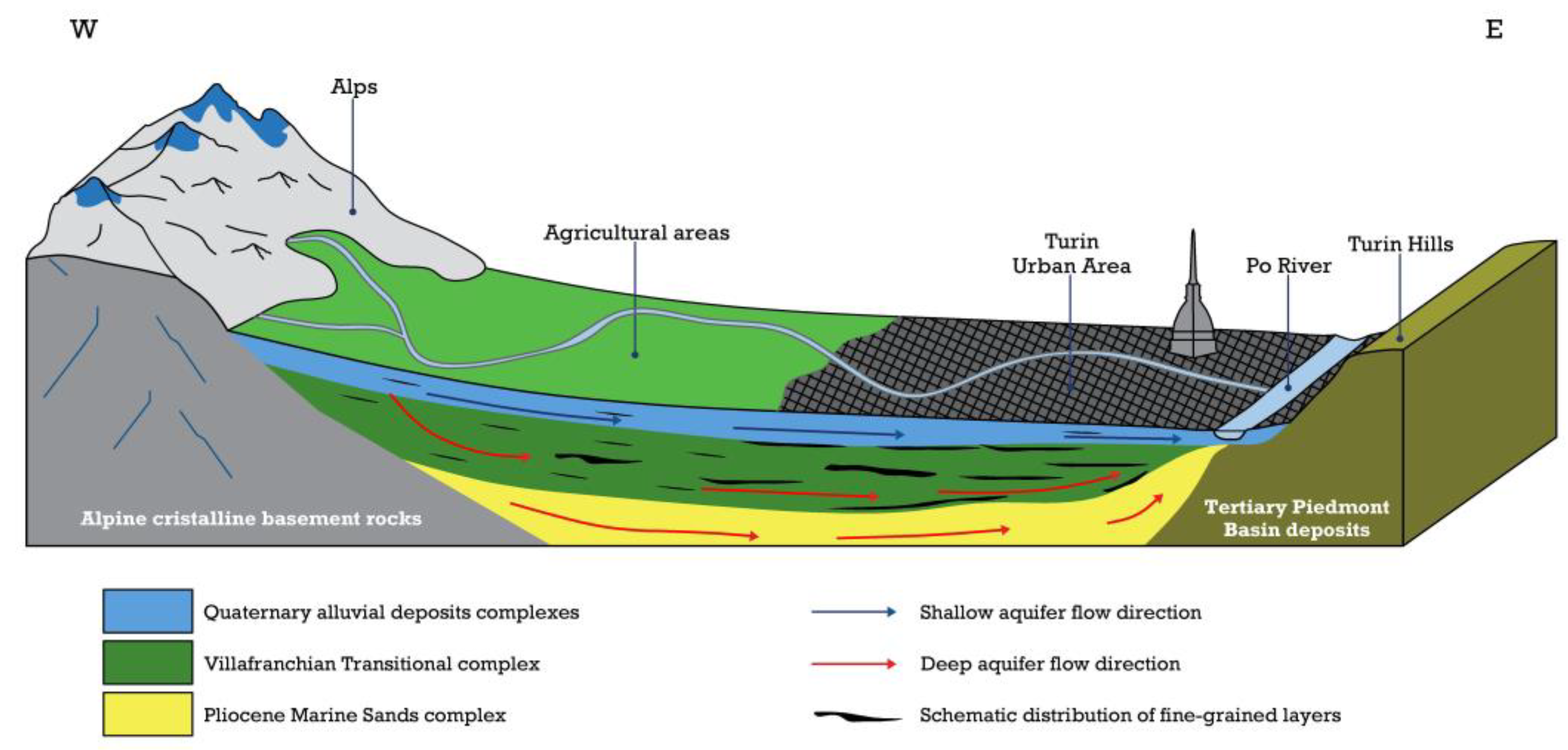
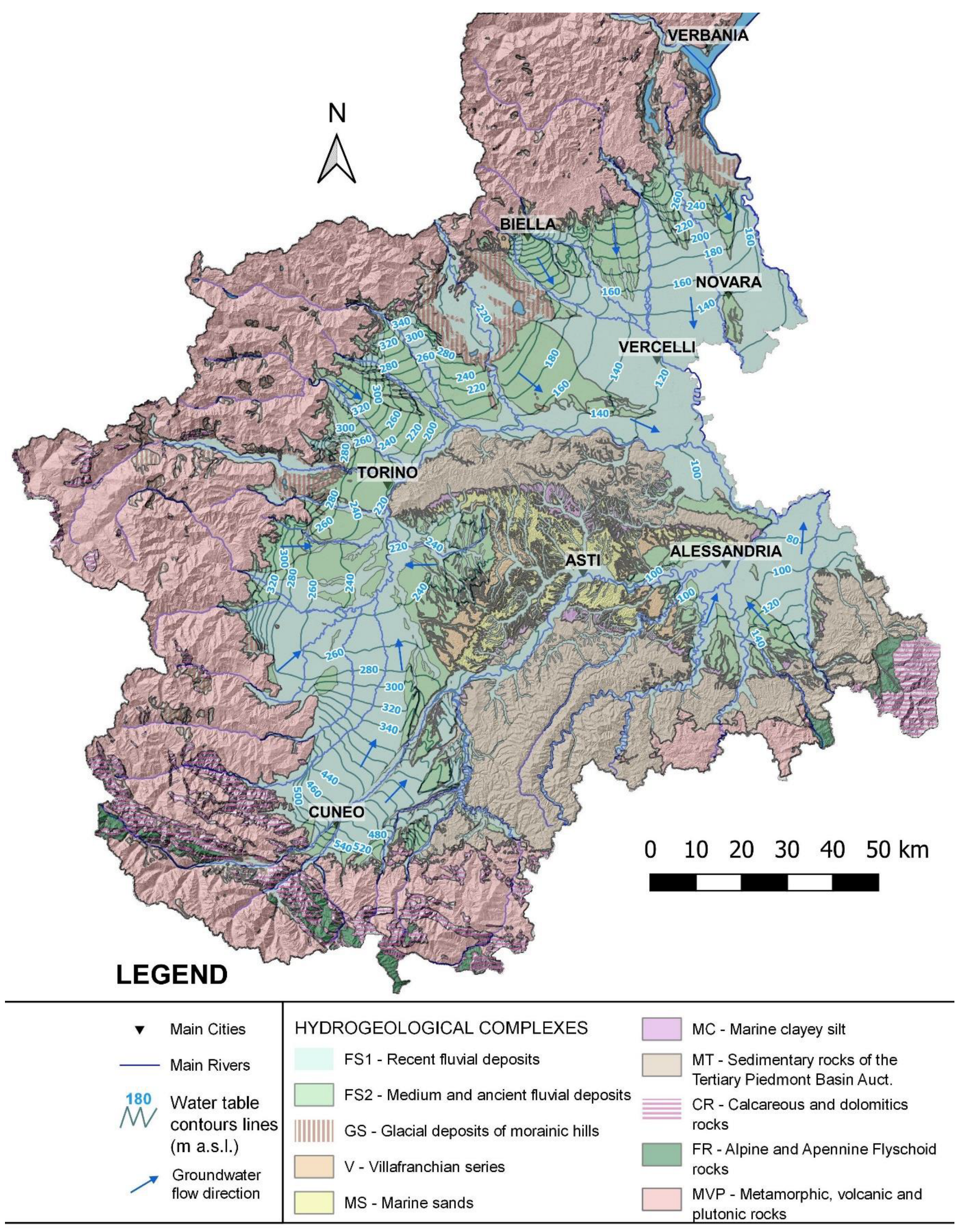


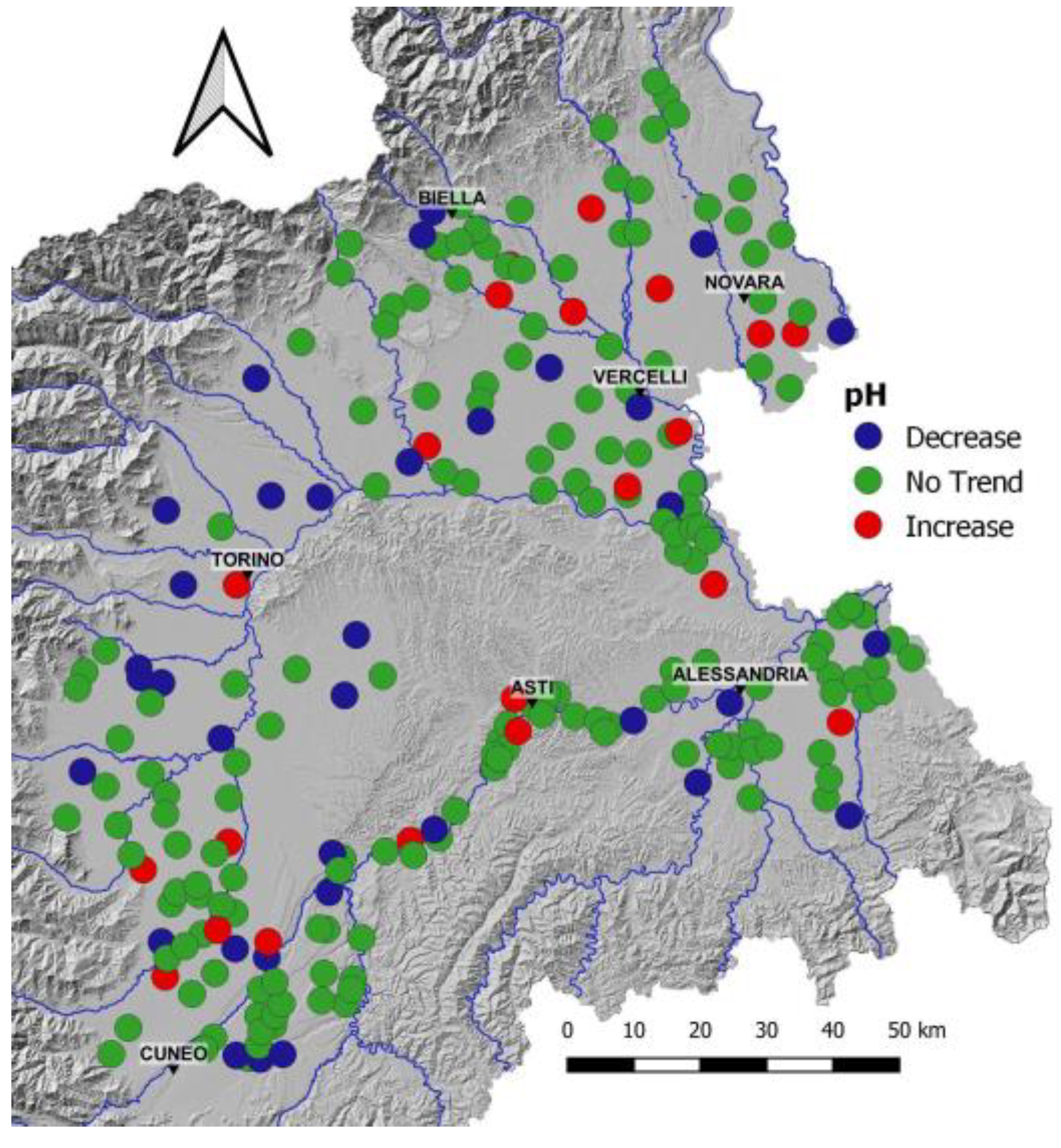

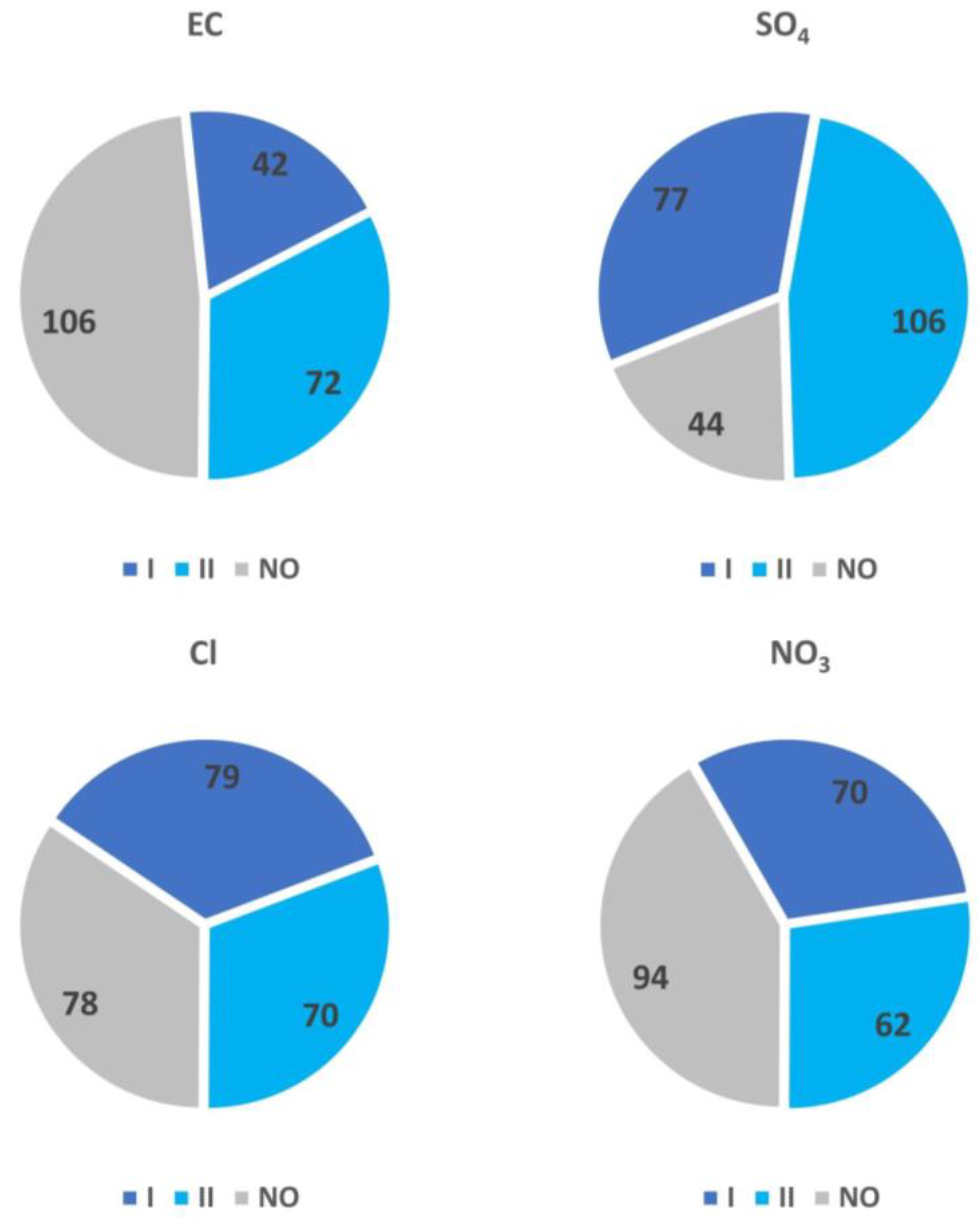
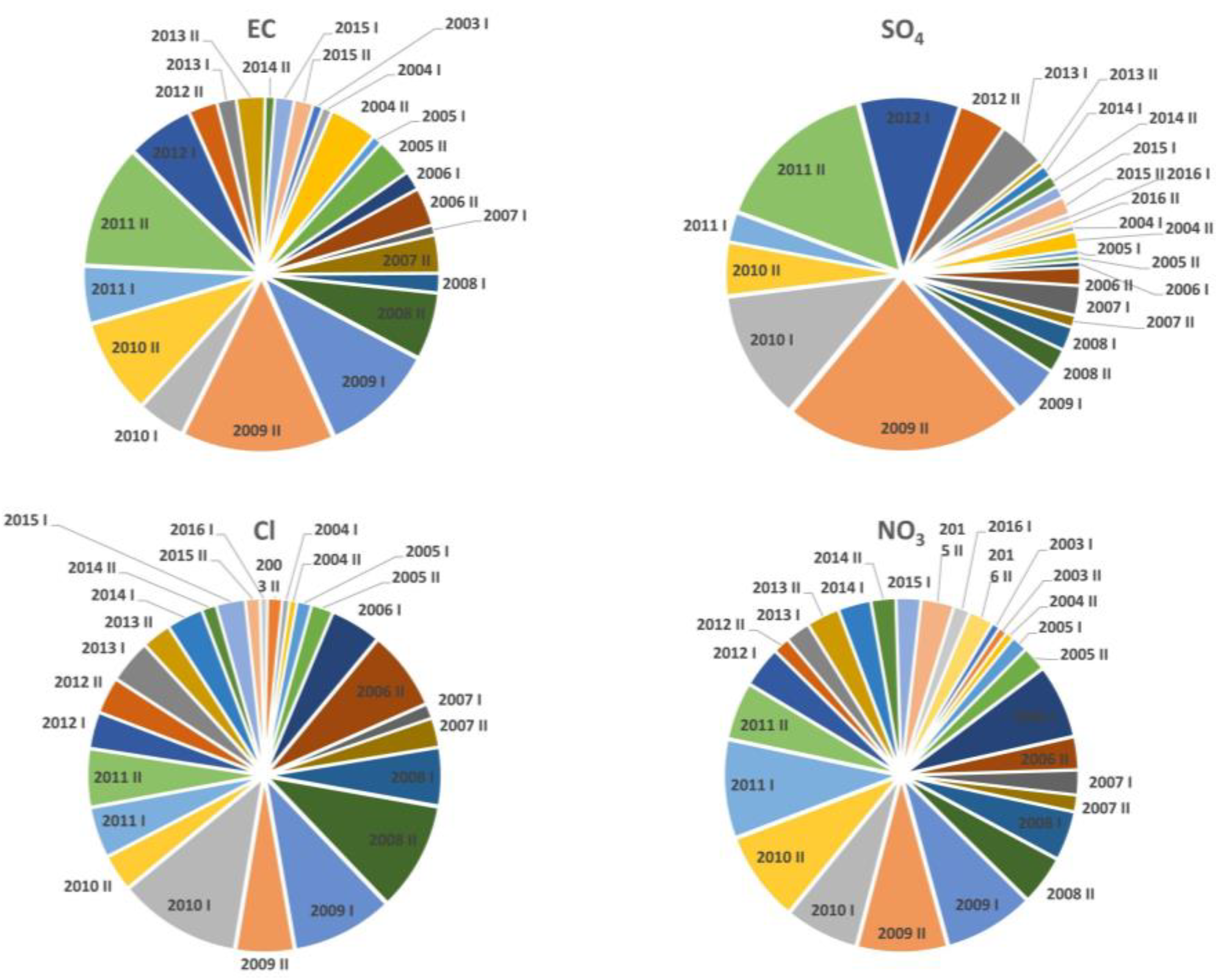
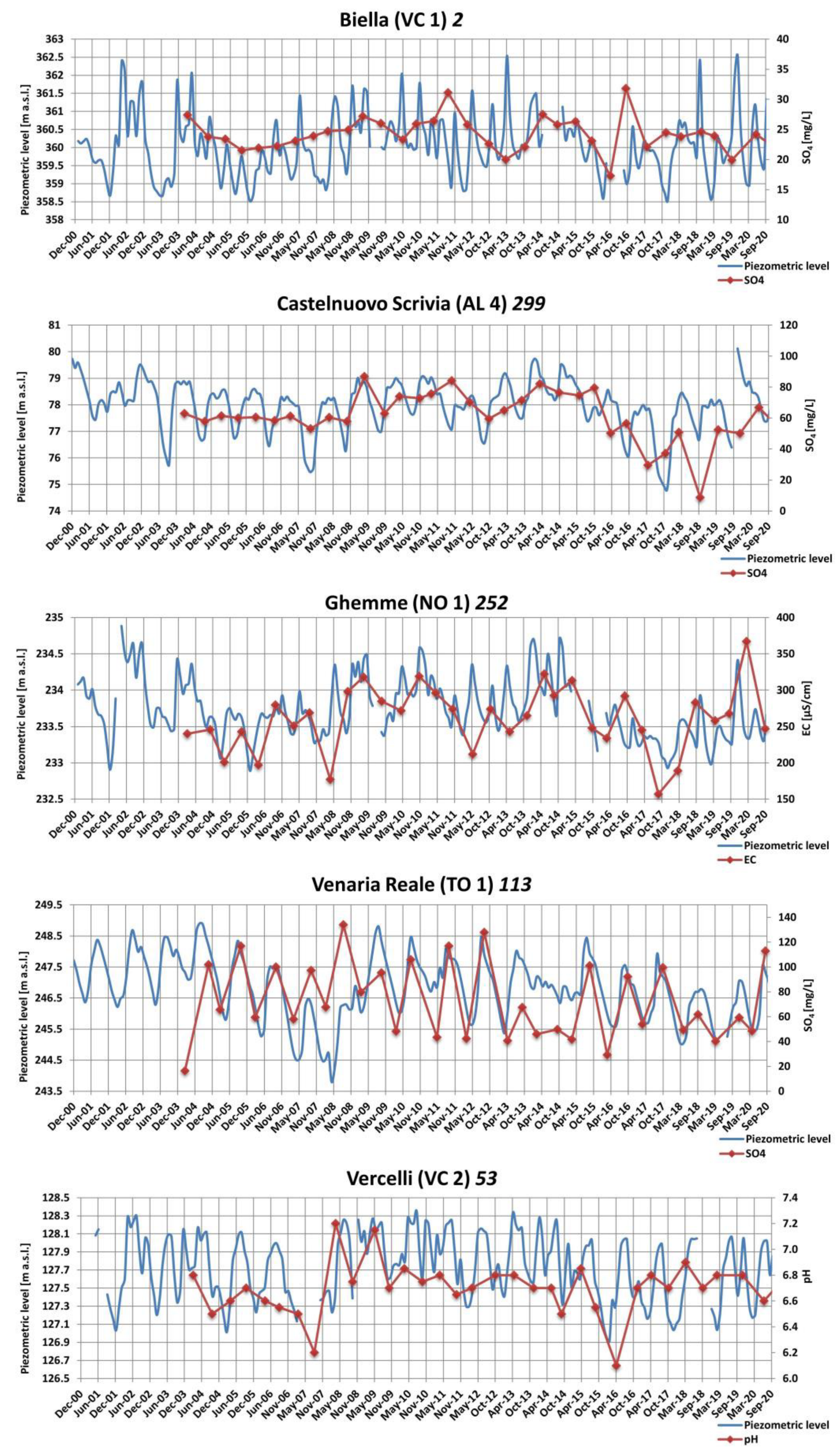
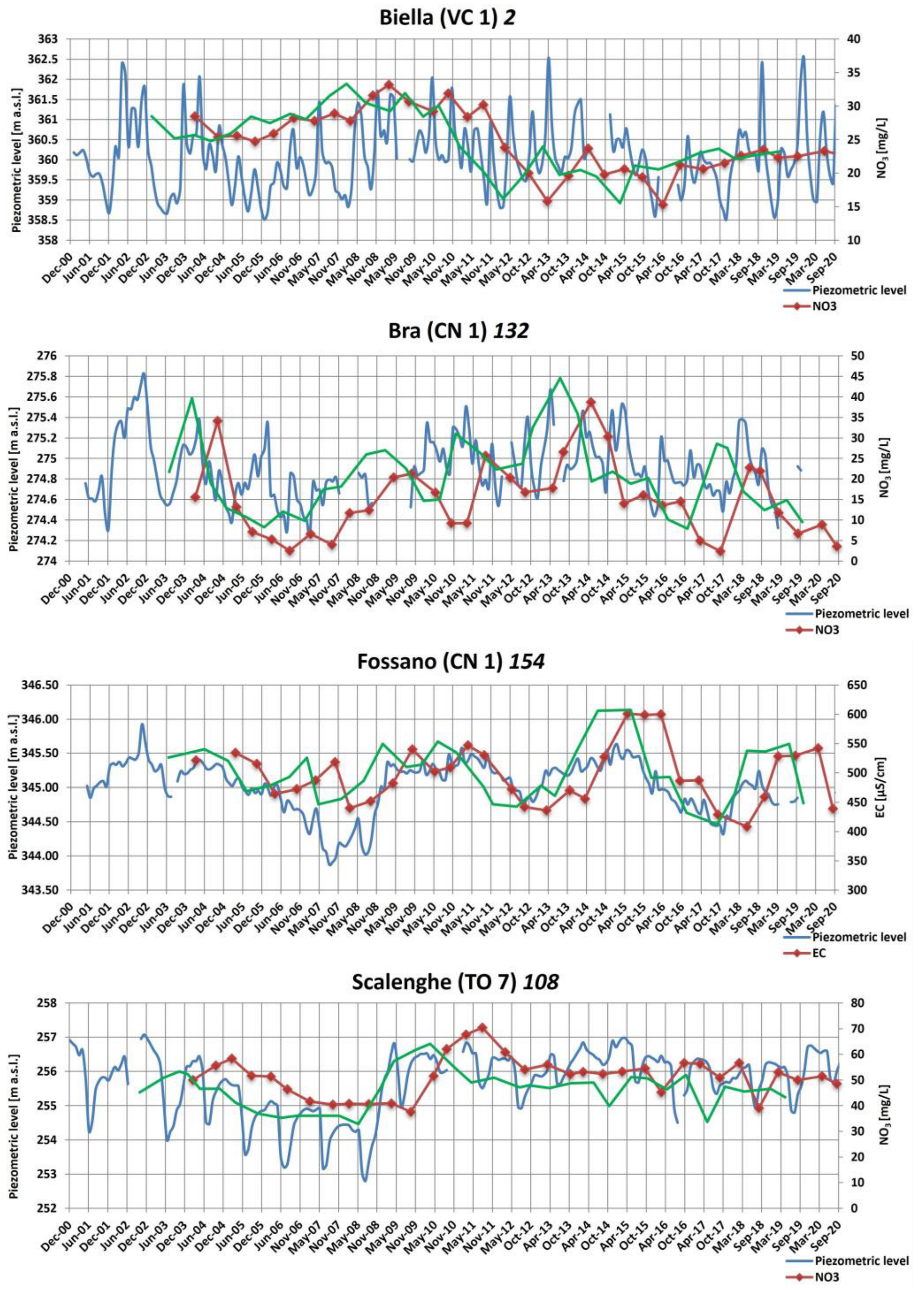
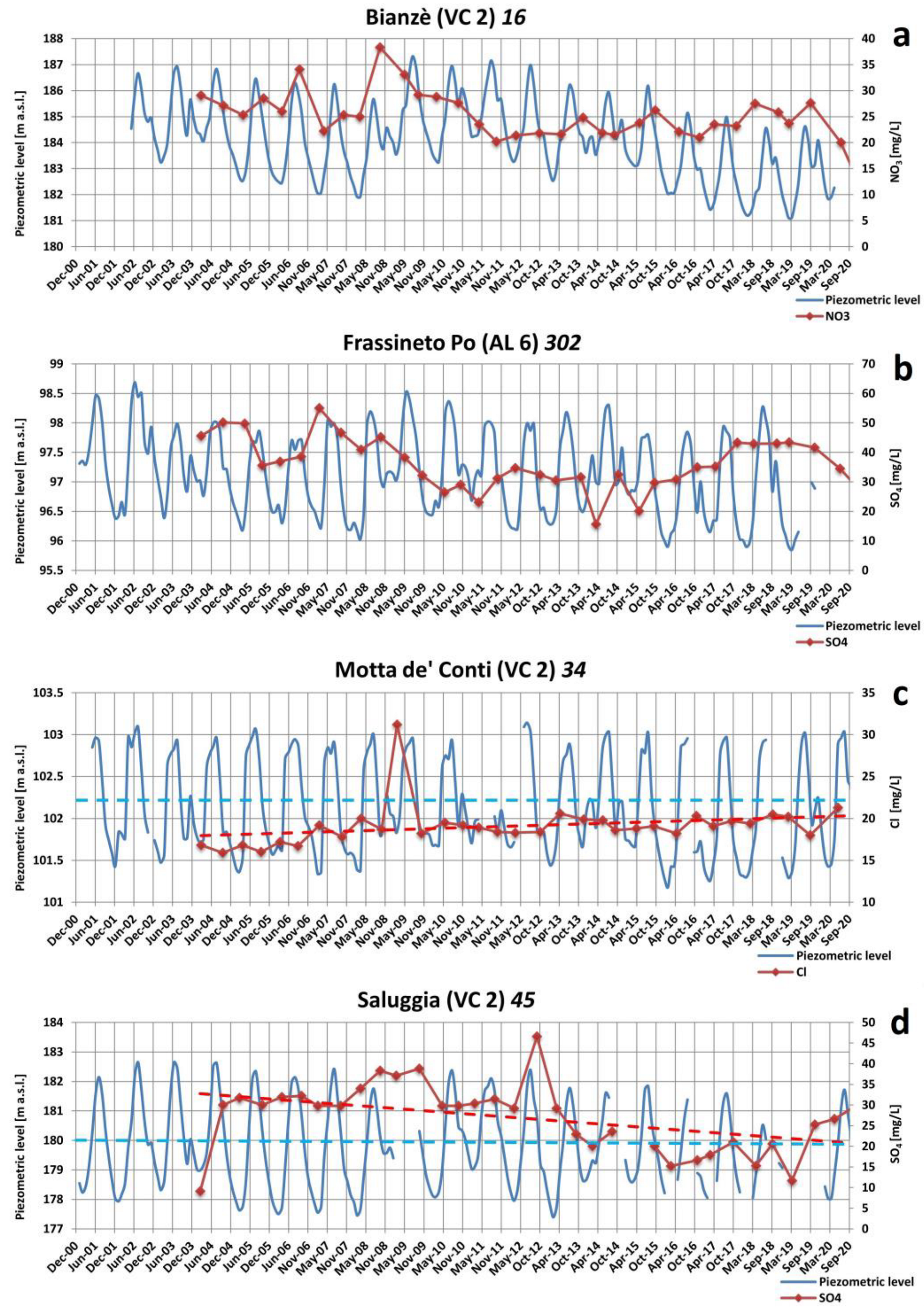
| EC | HCO3 | Ca | Mg | Na | Cl | NO3 | SO4 | pH | |
|---|---|---|---|---|---|---|---|---|---|
| + | 70 | 78 | 64 | 58 | 122 | 93 | 40 | 16 | 21 |
| − | 53 | 16 | 38 | 55 | 25 | 38 | 88 | 156 | 35 |
| No Trend | 104 | 133 | 125 | 114 | 80 | 96 | 99 | 55 | 171 |
| OLS | Trend | EC | HCO3 | Ca | Mg | NO3 | Cl | Na | SO4 | pH |
|---|---|---|---|---|---|---|---|---|---|---|
| Δ mg/L (μS/cm) | + | 172 | 43 | 17 | 4 | 12 | 31 | 19 | 25 | 0.4 |
| Δ mg/L (μS/cm) | − | 126 | 45 | 22 | 6 | 14 | 17 | 12 | 21 | 0.3 |
| Δ % | + | 20 | 21 | 26 | 22 | 55 | 54 | 48 | 58 | 5.0 |
| Δ % | − | 28 | 23 | 27 | 35 | 68 | 54 | 48 | 38 | 4.6 |
Disclaimer/Publisher’s Note: The statements, opinions and data contained in all publications are solely those of the individual author(s) and contributor(s) and not of MDPI and/or the editor(s). MDPI and/or the editor(s) disclaim responsibility for any injury to people or property resulting from any ideas, methods, instructions or products referred to in the content. |
© 2024 by the authors. Licensee MDPI, Basel, Switzerland. This article is an open access article distributed under the terms and conditions of the Creative Commons Attribution (CC BY) license (https://creativecommons.org/licenses/by/4.0/).
Share and Cite
Cocca, D.; Lasagna, M.; De Luca, D.A. Groundwater Chemical Trends Analyses in the Piedmont Po Plain (NW Italy): Comparison with Groundwater Level Variations (2000–2020). Water 2024, 16, 1240. https://doi.org/10.3390/w16091240
Cocca D, Lasagna M, De Luca DA. Groundwater Chemical Trends Analyses in the Piedmont Po Plain (NW Italy): Comparison with Groundwater Level Variations (2000–2020). Water. 2024; 16(9):1240. https://doi.org/10.3390/w16091240
Chicago/Turabian StyleCocca, Daniele, Manuela Lasagna, and Domenico Antonio De Luca. 2024. "Groundwater Chemical Trends Analyses in the Piedmont Po Plain (NW Italy): Comparison with Groundwater Level Variations (2000–2020)" Water 16, no. 9: 1240. https://doi.org/10.3390/w16091240






